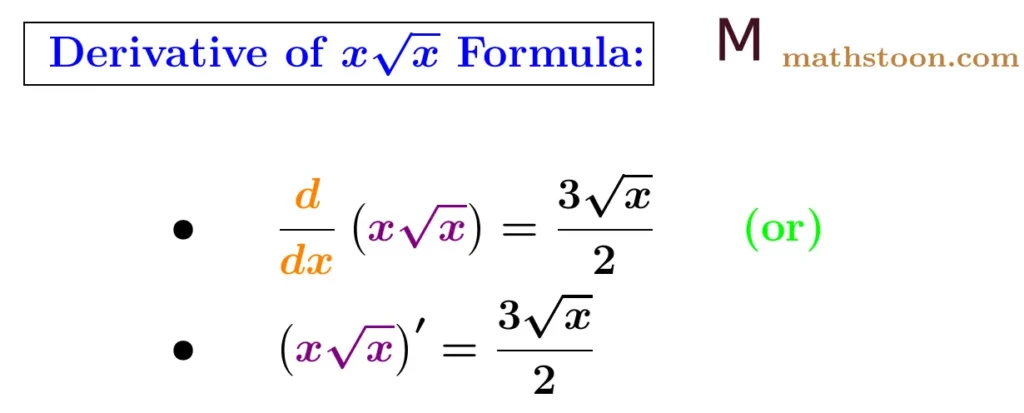The derivative x root(x) is equal to (3√x)/2. Note x root(x) is denoted by x√x, and its derivative as d/dx (x√x). In this post, let us learn how to differentiate x root(x) using the following methods:
- By power rule
- By first principle.

The derivative formula of x root(x) is given as follows.
$\dfrac{d}{dx}(x\sqrt{x}) = \dfrac{3\sqrt{x}}{2}.$
Table of Contents
By Power Rule
To find the derivative of x√x, let us first write it as a power of x. Note that √x = x1/2. So we obtain that
x√x = x ⋅ x1/2 = x1+ 1/2 = x3/2.
Differentiating both sides, we get that
| $\dfrac{d}{dx}(x\sqrt{x}) = \dfrac{d}{dx}(x^{3/2})$ = $\dfrac{3}{2} x^{\frac{3}{2}-1}$ by the power rule d/dx (xn) = nxn-1. = $\dfrac{3}{2} x^{\frac{1}{2}}$ = $\dfrac{3\sqrt{x}}{2}$. |
So the derivative of x root(x) by the power rule is (3√x)/2.
Also Read: Derivative of fourth root of x
Derivative of x root(x) by First Principle
The derivative of f(x) by first principle is denoted by d/dx (f(x)) and it is given by the limit formula below:
$\dfrac{d}{dx} (f(x))$ = limh→0 $\dfrac{f(x+h)-f(x)}{h}$.
Let f(x) = x√x. Note that
f(x) = x3/2 and f(x+h) = (x+h)3/2.
Then by first principle, the differentiation of x√x is
| $\dfrac{d}{dx}(x\sqrt{x})$ = limh→0 $\dfrac{(x+h)^{\frac{3}{2}}-x^\frac{3}{2}}{h}$ |
Put x+h = z. So z→x as h→0. Also, h=z-x.
Now, using the limit formula limx→a (xn-an)/(x-a) = nan-1, we deduce from above that
| $\dfrac{d}{dx}(x\sqrt{x})$ = limh→0 $\dfrac{z^{\frac{3}{2}}-x^\frac{3}{2}}{z-x}$ = $\dfrac{3}{2} x^{\frac{3}{2}-1}$ = $\dfrac{3\sqrt{x}}{2}$. |
Therefore, d/dx (x√x) = (3√x)/2.
So the derivative of x root(x) by first principle is (3√x)/2.
Related Topics:
Derivative of sin3x : The derivative of sin3x is 3cos3x.
Derivative of esinx : The derivative of esinx is cosx esinx.
By Logarithmic Differentiation
Let y = x√x = x3/2
Taking natural logarithms on both sides, we get that
ln(y) = ln(x3/2)
⇒ ln(y) = $\dfrac{3}{2}$ ln(x) by the log rule lnxk = k lnx.
Differentiating both sides with respect to x, we get that
$\dfrac{1}{y} \dfrac{dy}{dx} = \dfrac{3}{2} \cdot \dfrac{1}{x}$
⇒ $\dfrac{dy}{dx} = \dfrac{3y}{2x}= \dfrac{3x^{3/2}}{2x} = \dfrac{3\sqrt{x}}{2}$.
Hence, the derivative of x root(x) by the logarithmic differentiation is equal to (3√x)/2.
More Reading:
Derivative of 1/x : The derivative of 1/x is -1/x2.
Derivative of ln5x : The derivative of ln(5x) is 1/x.
FAQs
Answer: Using rule of indices, x root(x) = x3/2. So by the power rule, the derivative of x√x is equal to (3√x)/2.
Answer: d/dx (x√x) = (3√x)/2.
This article is written by Dr. T, an expert in Mathematics (PhD). On Mathstoon.com you will find Maths from very basic level to advanced level. Thanks for visiting.